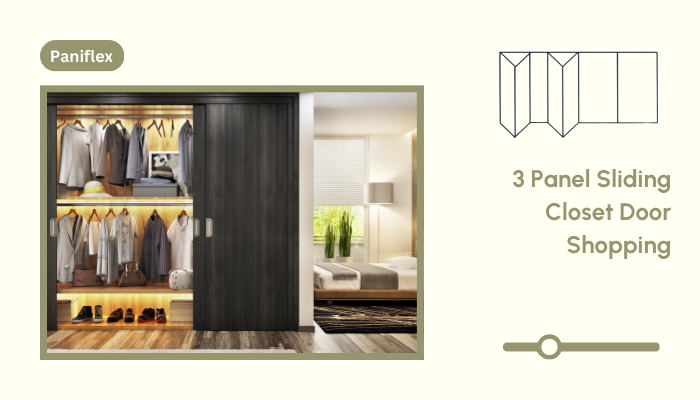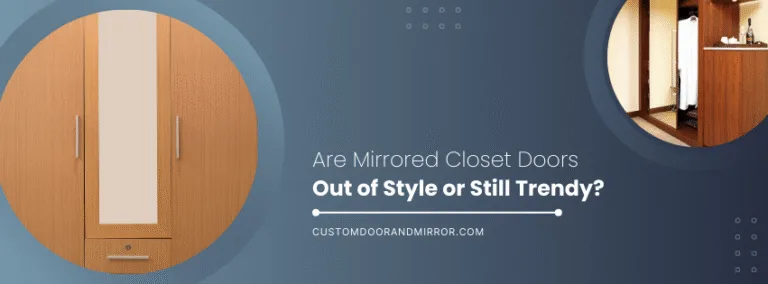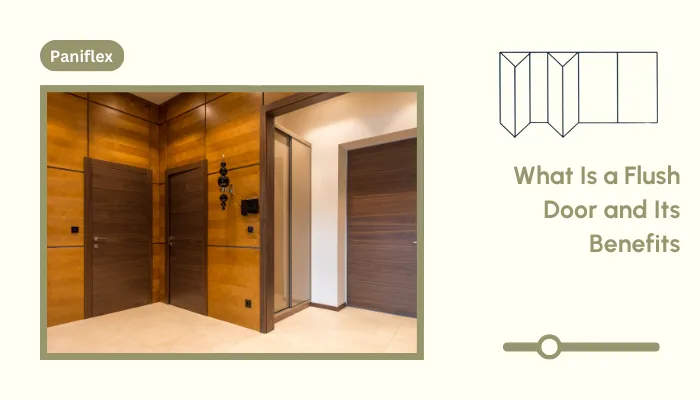Are you tired of old closet doors that take up too much space, clash with your decor, or don’t do their job? A sliding closet door, especially the 3-panel variation, provides stylish and space-saving options. These doors glide without a sound, offering modern touches and simple access to your storage areas.
In this article, we’ll discuss everything you need to know about 3-panel sliding closet doors, from standard and custom dimensions to materials, finishes, and installation tips.
Ready to experience the benefits of custom closet doors? Explore our range of Paniflex products now.
Whether you’re planning a DIY upgrade or consulting a professional, this guide will help you make informed decisions for a functional and visually appealing closet.
So, let us dive right in.
Introduction to 3-Panel Sliding Closet Doors
Sliding closet doors have become more popular lately. They offer a slim fit and save a great deal of space. Three-panel sliding doors shine with versatility and modern appeal.
These glide up and down over a track with absolute ease and clear swing without the need to account for any opening clearance. They are ideal for use in bedrooms, living rooms, and even offices, allowing for an effortless and stylish approach to storage.
Here are some of the features of 3-panel sliding doors.
Unique Features of 3-Panel Sliding Doors:
- Three swinging panels allow for access from any corner.
- Offered in a number of materials and finishes to coordinate with any home décor.
- Designed for both expansive and compact areas.
- Clean and sleek design keeps visual clutter down while maximizing aesthetics.
- Optional mirrored panels for more functionality and the visual effect of adding more space to a room
- Smooth-glide mechanisms that work quietly and almost effortlessly
- Optional customizable panel layouts for unique storage requirements or preferred styles.
Benefits of 3-Panel Sliding Doors:
Here are some of its features:
1. Space Saving Attributes:
- Uses less floor space compared to hinged doors.
- Helps in the reduction of visual clutter that makes a room look bigger and more spacious.
2. Design Improvements
- Customization to suit personal style
- Adding value to a property by enhancing the modern, functional look
3. Functional Benefits
- Easier to install and use with a smooth opening
- Flexibility for access – the panels are movable according to the usage of space
- Maintenance requirements are relatively low compared to those of traditional hinged doors.
Now, let us consider the measurement of a 3-panel sliding door.
Standard Dimensions of 3-Panel Sliding Closet Doors
Understanding the dimensions of 3-panel sliding closet doors is crucial for ensuring a seamless fit and functional design.
Let’s go through the general measurements, different options for personalization, and tips on choosing doors for your space.
Common Widths and Heights:
Most 3-panel sliding closet doors come in standard dimensions, making it easy to find a size that fits your space. Common widths include 5 feet, 6 feet, and 8 feet. Heights of 80 inches and 96 inches are also quite common.
Most of the available closet openings have a place under these dimensions while having a nice, balanced, practical appearance. Further, they offer themselves both room sizes, compact and wide-open master rooms.
Designing Idea:
Consider taller ceilings with custom heights to really make the space pop visually and functionally. Doors that extend to the ceiling create a seamless, modern look while optimizing storage.
Taller doors can also help conceal overhead shelves, which can make the closet look cleaner and more organized.
Variations Based on Manufacturer and Region:
Some manufacturers and regions may offer slight variations in standard dimensions, so always check the specifications before purchasing. A visual dimension guide can help you better understand how the doors will fit in your space.
Also, consider regional trends or climate adjustments and select a suitable door based on your preference to endure humidity and fluctuations in temperatures.
Some manufacturers and regions may provide slight variations of standard dimensions. It is important to check the specifications before buying. A visual dimension guide will help you better understand how the doors will fit in your space.
Next, we’ll explain how to customize your door dimensions according to your needs. Here’s how.
Customizing Door Dimensions
Customization is the way to ensure your sliding closet doors fit perfectly in your space and align with your style preferences. Whether you have unique openings or just want a tailored look, customizing door dimensions allows you to achieve that perfect balance between functionality and aesthetics. Here’s how to do it:
Step 1. Measuring Your Closet Opening:
Getting the dimensions right is the first step to finding the perfect fit. Here’s how you can measure accurately:
Measure the width of the opening at three points:
- Top: Measure across the top of the opening.
- Middle: Measure across the center of the opening.
- Bottom: Measure across the bottom of the opening.
Note: Always use the smallest measurement to ensure the doors fit correctly.
Step 2. Measure the height of the opening at three points:
- Left side: Measure vertically from the floor up to the top of the opening.
- Center: Measure vertically in the middle.
- Right Side: Measure vertically on the right side.
Note: Use the smallest measurement for an accurate size.
Step 3. Check for frame unevenness:
- Use a level to determine if the frame is even.
- Account for unevenness during installation by adjusting the track or using shims.
When to Consider Custom Sizes:
- Older homes: Standard sizes may not align with non-standard or older architectural designs.
- Unique spaces: Oddly shaped or oversized closet openings require custom dimensions.
- Design flexibility: Custom doors allow for unique panel configurations and styles to match your decor and functional needs.
Cost Implications of Custom Dimensions:
- Materials: Custom dimensions often require additional materials, which can increase costs.
- Labor: The manufacturing process for custom doors is more complex, leading to higher labor expenses.
- Installation: Custom sizes may require specialized installation techniques, adding to the overall cost.
Budget Tips:
- Plan for additional expenses when opting for custom sizes.
- Balance the need for tailored dimensions with pre-set designs to manage costs effectively.
- Request quotes from multiple manufacturers to compare prices and find the best value.
Searching for a partner that understands your architectural needs? Paniflex supports architects, contractors, and designers in every stage of their process with custom doors and mirrors to help smooth out workflows and guarantee exceptional results.
So, how do you choose the right material and finish for your 3-panel sliding closet doors? Let’s help you understand.
Materials and Finishes For 3-Panel Sliding Doors
Choosing the right materials and finishes for your 3-panel sliding closet doors can significantly improve their functionality and style. Let us explore the most popular materials, their advantages, and the variety of finishes available to help you create a design that complements your space. Here are some of the common materials:
1. Wood:
- Description: A classic choice known for its timeless appeal and durability.
- Applications: Best for traditional or rustic designs where warmth and natural texture are desired.
- Additional Notes: Can be painted or stained to suit specific aesthetic preferences.
2. Glass:
- Description: Adds a sleek, modern look to any space.
- Applications: Ideal for contemporary and minimalist interiors.
- Additional Notes: This product is available in clear, frosted, or mirrored options, which offer varying levels of privacy and light reflection.
3. MDF (Medium-Density Fiberboard):
- Description: A cost-effective option with smooth surfaces that can be easily customized.
- Applications: Suitable for budget-friendly projects without compromising on style.
- Additional Notes: Often finished with veneers or laminates for added durability and style.
| Material | Pros | Cons |
| Wood | Durable, elegant, versatile | Heavy, more expensive than others |
| Glass | Sleek, spacious appearance | Fragile, requires regular cleaning |
| MDF | Affordable, easy to finish | Less durable, susceptible to water damage |
| Aluminium | Lightweight, modern, rust-resistant | Limited design options can feel industrial |
| PVC | Cost-effective, moisture-resistant | Less durable, limited high-end finishes |
Available Finishes:
1. Matte Finishes:
- Give a subtle, low-key appearance that is well-suited for modern and minimalist designs.
- Good for rooms where glare or reflective surfaces are undesirable.
2. Gloss Finishes
- Give a highly polished, upscale appearance.
- Ideal for contemporary interior designs or smaller rooms to add light reflection
3. Textured Finishes
- Create depth and personality in the doors, such as replicating the look of wood grain or stone.
- Ideal for rustic, industrial, or eclectic design themes
4. Reflective Finishes (Mirrors)
- Create the illusion of extra space, making it ideal for smaller rooms.
- Doubles as a useful mirror, adding functionality to the attractiveness.
5. Hybrid Finishes:
- Different textures, such as matte wood with a glossy glass pane,l can be combined for a different look.
- Add dynamic visual elements to multi-functional spaces.
Additional Tips for Choosing Materials and Finishes:
1. Match Your Room’s Style:
- Consider the overall decor of your space when selecting materials and finishes.
- For instance, a warm wood tone complements traditional furniture, while frosted glass pairs well with minimalist designs.
2. Factor in Maintenance:
- Wood may require refinishing over time.
- Glass needs regular cleaning to maintain its sleek look.
- MDF should be kept dry to prevent swelling or warping.
- Aluminum is virtually maintenance-free ideal for humid environments.
3. Combine Materials for a Unique Look:
- Mix and match materials, such as a wood frame with frosted glass panels, to create a unique, customized design.
- Consider PVC or aluminum for sections prone to moisture or wear and tear.
By carefully considering the material and finish options, you can select 3-panel sliding doors that not only fit your functional needs but also elevate the aesthetic of your room.
Paniflex understands that every project is unique. Their custom doors fit seamlessly into your designs, adapting to any existing structure without modification. This means you can maintain the flow of your design while addressing spatial challenges with ease.
So, how do design styles and aesthetics impact the look of your space? Let us find out.
Design Styles and Aesthetics
The design style and aesthetic of your 3-panel sliding closet doors can be a great deal in making or breaking the whole look and feel of your space. Be it sleek modern designs or the traditional charm that time never goes out of fashion with, finding the right aesthetic is sure to blend your closet doors with your room’s decor seamlessly while adding some personality. Let us explore further:
Modern and Contemporary Designs
Modern designs are simple and elegant. Most of them feature clean lines, neutral colors, and minimalist hardware that blend seamlessly into contemporary interiors.
Frosted glass or mirrored panels are common, adding functionality and enhancing the aesthetic. Aluminum frames are often used for their sleek, lightweight properties, and matte or glossy finishes add a touch of refinement and polish.
Traditional and Classic Styles
Traditional designs are characterized by timeless charm and intricate craftsmanship. Wooden frames with detailed carvings or embellishments are perfect for these styles.
Warm, natural finishes in oak, mahogany, or walnut add the classic appeal of warmth and welcome. These styles often complement textured finishes or ornate hardware for an authentic and elegant look.
Integrating Doors into Existing Decor:
- Harmonizing with Colors: The door material and finish should match the existing furniture, wall colors, or flooring to ensure a cohesive look.
- Create a Focal Point: Use mirrored or frosted glass panels to highlight the closet doors as a design element.
- Balancing Aesthetics and Functionality: Combining materials like a wood frame with glass panels can bring together traditional and contemporary styles.
- Personalized Touches: Add decorative hardware or custom engravings to reflect your unique style while maintaining harmony with the room.
Match the door material and finish with other elements in your room, such as furniture or wall colors. This ensures a cohesive look that enhances your space.
So. how do you properly install a 3-panel door? Here are the steps you can follow.
Installation Process of 3-Panel Sliding Doors
Installing 3-panel sliding closet doors can seem intimidating, but with the right preparation and planning, it is easy, rewarding, and fun.
Here’s detailed step-by-step information to ensure the installation goes smoothly. It addresses some common pitfalls and offers solutions to deliver professional-quality results.
Before installing, make sure all of the needed tools are pre-ready:
- Tape measure: To measure the length.
- Level: To maintain proper alignment.
- Screwdriver and drill: For fixing parts.
- Cleaning agents: To clear the frame from any dust or obstructions.
Step-by-Step Installation Guide:
Step 1. Prepare the Track System:
- Unpack all parts and check that you have all the parts that you need
- Assemble the track system based on the manufacturer’s instructions
- Clean the frame section to remove dust or obstructions that may hinder track installation
Step 2. Mount the Track
- Mount the track in place by ensuring it is level. The use of a level ensures correct alignment throughout
- Tighten screws or brackets to avoid shifting during use
Step 3. Insert the Door Panels
- Start with the rear panel, slipping it into the track without scuffing
- Next, work on the central and front panels, making sure each slides in with less friction
- Fine-tune where the panels go so they do not overlap incorrectly.
Step 4. Alignment adjustment
- Make sure the doors open and close completely by using the adjustable screws or mechanisms.
- Run your hand on the panels. They should have no resistance, sliding smoothly along the track.
Step 5. Fasten the Doors
- Tighten all screws and brackets to hold the panels firmly in place.
- Test the sliding mechanism several times to ensure it slides smoothly.
Common Challenges and Solutions:
Here are some of the common challenges and their solutions for 3-panel sliding doors.
- Uneven Frames:
- Problem: Uneven or slanted frames can cause alignment issues.
- Solution: Insert shims to form a level base before mounting the track system.
- Misaligned Tracks:
- Problem: Tracks not installed at the installed level can lead to poor panel movement.
- Solution: Retake measurements, then level and secure the track.
- Panel Sticking or Difficulty Sliding:
- Problem: Dust or debris in the track may block the way.
- Solution: Keep the track clean and lubricate rollers to run smoothly.
By following these guidelines and common troubleshooting, you’re sure to avoid any problems on the way toward a smooth 3-panel sliding closet door installation.
3 – Panel Sliding Doors: Maintenance and Care Tips
Proper maintenance and care are essential for keeping your 3-panel sliding closet doors functioning smoothly and looking their best. Here are some practical tips for routine cleaning, preventing common issues, and ensuring the longevity of your doors. Here’s how to do it.
1. Routine Cleaning Tips:
- Use a soft cloth and mild cleaners to clean, but avoid using chemicals, as they can sometimes damage finishes and materials.
- Dust the tracks weekly to prevent debris buildup that might hinder smooth operation.
- Clean the glass doors streak-free using a streak-free glass cleaner and microfiber cloth to maintain transparency.
2. Preventing and Addressing Common Issues:
- Track Maintenance:
To maintain smooth panel sliding, dirt, hair, and other debris must be removed from the tracks, and a silicone-based lubricant must be periodically applied.
- Roller Inspection:
Check rollers periodically for wear and tear and replace them immediately if damaged or worn out to avoid uneven sliding or door misalignment.
- Seal Protection:
Inspect the seals around the panels’ edges to ensure that they are intact and functional. Replace cracked or damaged seals to prevent noise and improve insulation.
3. Extending the Lifespan of Your Doors:
- Tighten any loose screws or hardware during routine inspections.
- Replace worn-out components, such as rollers or handles, as needed to maintain functionality.
- If you have wooden doors, consider refinishing them periodically to protect against wear and environmental damage.
- Store spare parts, like extra rollers or track covers, for quick fixes in the future.
- Schedule professional servicing annually if the doors are heavily used or in high-traffic areas.
You deserve products that match your high standards, and Paniflex delivers just that. Their commitment to quality and innovation ensures that every custom door meets your expectations.
You can trust their products to seamlessly blend functionality with aesthetic appeal, elevating the overall quality of your projects.
Whether you’re shaping an elegant interior or ensuring structural integrity, Paniflex’s solutions align perfectly with your goals.
Now that we know a lot about 3-panel sliding closet doors let us learn about their cost considerations.
3-Panel Sliding Closet Door: Cost Considerations
The cost of 3-panel sliding closet doors depends on several factors, including:
1. Material Selection:
- More expensive materials, such as solid wood or tempered glass, are used in comparison to cheaper alternatives, such as MDF or basic glass.
- Additional features, such as moisture resistance or soundproofing, may also add to the overall cost of materials.
2. Customization:
- Customized sizes and designs may involve extra materials and labor, making the product more expensive.
- Unique finishes or a mix of materials, such as frosted glass with aluminum frames, add to the cost.
3. Installation Costs:
- Professional installation ensures a precise fit but can significantly increase expenses.
- DIY installation may save money but requires time, tools, and effort.
Budgeting Tips:
- Set Priorities: Decide on the features that matter most, such as durability, style, or budget-friendliness, to focus spending wisely.
- Standard Sizes Must be Chosen: Standard dimensions save money on customization fees.
- Compare Materials: Mix materials like MDF with decorative accents for a cost-effective yet stylish option.
- Get multiple quotes: Ask for quotes from different manufacturers or contractors to determine which offers the best value based on your budget.
- Plan for Long-Term Value: While high-quality materials may have a higher upfront cost, they often provide better durability and aesthetics, reducing the need for frequent replacements.
Balance cost with aesthetics and durability. For a cost-effective solution, opt for standard sizes and materials or invest in custom designs for a unique look.
Ready to experience the benefits of custom closet doors? Explore our range of Paniflex products now.
Conclusion
The right 3-panel sliding closet doors can make all the difference in functionality and aesthetics. With their versatile designs and material options, these doors optimize storage and elevate the visual appeal of any room.
Whether you prefer modern minimalism, traditional elegance, or a blend of both, there’s a perfect fit for every need.
Focus on dimensions, materials, and design styles that fit your needs and budget. Explore customizations to achieve the ideal balance of style and utility.
Ready to transform your closet into a functional and stylish feature of your home? Explore the endless possibilities, and consult a professional if necessary to bring your vision to life.With BIM virtual reality and other innovations, key plans can now be quite dynamic. Start your next project with a trusted key plan, and Paniflex can bring all your ideas together. Book your free call now to see how Paniflex can help make your success happen.






